
Opening Preparation
Mark Dvoretsky and Artur Yusupov
With contributions from:
Sergei Dolmatov
Yuri Razuvaev
Boris Zlotnik
Aleksei Kosikov
Vladimir Vulfson
Translated by Joint Sugden
В. T. Batsford Ltd, London
First published 1994
© Mark Dvoretsky. Artur Yusupov 1994 Reprinted 1994, 1996 ISBN 0 7134 7509 9
British Library Cataloguing-in-Publication Data. A CIP catalogue record for this book is available from the British Library.
Ail rights reserved. No part of this book may be reproduced, by any means, without prior permission of the publisher.
Typeset by John Nunn GM and printed in Great Britain by Redwood Books, Trowbridge, Wilts for the publishers, В. T. Batsford Ltd, 4 Fitzhardinge Street, London W1H0AH
A BATSFORD CHESS BOOK
Editorial Panel: Mark Dvoretsky, John Nunn, Jon Speclman
General Adviser: Raymond Keene OBE
Commissioning Editor: Graham Burgess
17 tff3 £g7
18 3e4?!
White could already have played the combination he plays next move.
18 ... Sd8 (93)
(The following games were mentioned in the lecture; they will give you a fuller idea of the opening variations discussed.)
Pctrosian-Pachman
Bled 1961
King’s Indian Attack
|
1 |
£f3 |
cS |
|
2 |
g3 |
®c6 |
|
3 |
Ag2 |
g6 |
|
4 |
0-0 |
£g7 |
|
5 |
d3 |
e6 |
|
6 |
c4 |
£>gc7 |
|
7 |
Sei |
0-0?! |
As wc have already seen, 7...d6 should be played here.
|
8 |
eS! |
d6 |
|
9 |
ed |
e'xd6 |
|
10 |
£bd2 |
Wcl |
|
11 |
Qb3! |
£d4? |
Better is H...b6 12ДГ4’«Ъ7.
12 ДГ4 ЙЪб
13 £>e5 ФхЬЗ
14 £k4!
More precise than 14 ab ^d5 15 £ic4 й'сб.
14 ... «Ъ5
14...Vd8 15 ab, with threats of 16 JLd6 and 16 Za5.
IS ab a5
The threat was 16 3a5.
16 ^d6 ДГ6
93
17
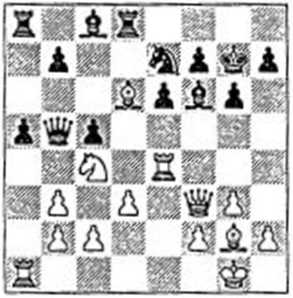
|
19 |
^xf6+! |
ФхГб |
|
20 |
AeS+ |
Ф&5 |
|
21 |
-S-g7! |
1-0 |
Smyslov-Denker Match USSR-USA. Moscow 1946 Sicilian
|
1 |
e4 |
cS |
|
2 |
ФеЗ |
4k6 |
|
3 |
g3 |
g<5 |
|
4 |
Ag2 |
£g7 |
|
5 |
d3 |
c6 |
|
6 |
ДеЗ |
Qd4?! |
|
7 |
£tec2! |
d6 |
|
8 |
c3 |
£c6 |
8...£>xe2 looks more natural.
9 d4 cd
10 £xd4!
White needs to recapture with piece so that he can later exploit th weak d-pawn.
10 £)xd4
Better is 11...41f6.
14 0-0 Деб
15 *'d2 Wc7 (94)
15...d5 fails to 16 Дс5.
94 iv
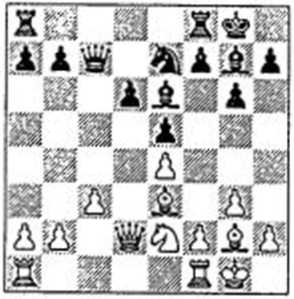
16 Sfcl!
To consolidate his hold on d5, White has to prepare c3-c4. 16 b3, with the same objective, would be weaker in view of 16...b5 (17 a4 ba 18 Exa4 ДхЬЗ). Now, however, 16...b5 can be met by 17 a4! a6 (17...ba 18 Sxa4 a5 19 Zeal, threatening 20 b4) 18 3dl, e.g: 18...Ead8 19 ab ab 20Ea7’, or 18...Sfd8 19 ab ab 20 Exa8 Exa8 21 O'xd6; or 18...ДЬЗ 19 Wxd6 Wxd6 20 Sxd6 Дха4 21 43c 1, preparing 22 b3.
17 c4
18...Дхс4 1943xe4d5 2043g5! is dangerous for Black.
19...43d4 is met by 20 c5! d5 21 43g5 ДП 22 f4 with an attack.
21...Дхс4 22 Each
22 Zacl
White is aiming for an advantageous exchange of light-squared bishops. 24...ФЬ7 can be answered by 25 Дс4! (with the idea of 26 h4), or by 25 43b5 and 26 Wd3.
|
24 ... |
<e7 | |
|
25 |
Д65 |
ФИ7 |
|
26 |
Дхеб |
#xe6 |
|
27 |
Ed3 |
3c7 |
|
28 |
Ecdl |
ЗГ7 |
|
29 |
£e4 |
ДГ8 |
|
30 |
Ed5 |
Wg4 |
|
31 |
Eld3 | |
31 43xd6?J walks into 31...Дхё6 32 Exd6 Wxdl+1.
After the text the game continued 31...Дс7 32 43xd6 Дxd6 33 Exd6 Zdf8 34 Wxe5 Exf2 35 Ed7+ Е2Г7 36 Zxf7+ Zxf7 37 Ed8! Sg7 38 We8 g5 39 «Ъ8+ $g6 40 Ed6+ ФГ7 41 *'xh6 Wf5 42 Sdl! >c5+ 43 £g2 We7 44 Ef 1+ <£g8 45 Wf6 Ш 46 Wf5 g4 47 3f2 We7 48 Wd3 Sg5 49 Ec2 Ш 50 We4 Eg7 51 Wd5+ ЙТ7 52Ее6! 1-0.
Dolmatov-Bagirov
Frunze 1983 Griinfeld Defence
|
1 |
c4 |
4if6 |
|
2 |
4k3 |
d5 |
|
3 |
cd |
43xd5 |
|
4 |
d4 |
86 |
|
5 |
c4 |
фхсЗ |
|
б |
be |
Дб7 |
|
7 |
ДаЗ |
£d7 |
|
8 |
•ггз |
с5 |
|
9 |
«ЬЗ |
0-0 |
|
10 |
ДdЗ |
Obviously stronger than 10 Де2 cd 11 cd fcf6. On 10 Ed 1. ECO recommends 10...cd 11 cd Ф16 12 Ji.d3 Дб4 13 Wxb7 ДхГЗ 14 gf-«Fxd4 15 0-0 (15 Wxc7?! tc3+ 16 Фе2 €kl5!) 15...We5 16 Дхе7 Sfb8 17 ДхГб Wxf6 18 Wc7 Wxf3 with equality.
10 ~ Ь6?!
In Evans-Korchnoi, Buenos Aires 1960, Black played more actively with 10...Wc? 11 0-0 Sb8 (intending to continue ...b7-b5); after 12 ДЬ5 b6 13 Sadi a6 14 Ad3 b5 15 Abl ДЬ7, he obtained an excellent position.
11 Sdl
11 0-0?! allows ll...€k5! with equality.
11 ... c6
12 0-0 ^c7 (95)
95 W
■ ЙТИАИ
13 e5!
The start of a sharp plan for a kingside attack, typical of such positions.
13 ... ДЬ7
14 £g5 Sfc8
14...h6? 15 £хсб! #с6 16 d5.
15 Sibl Sab8
16 h4 b5
Black's queenside pawn advance comes too late. A better move was 16...Wc6!, threatening mate and intending ...Ф'а4.
17 h5 b4
18 hg! ba
18...hg is answered by 19 Axg6 fg 20 £xc6 tfc6 21 d5.
19 gf+ ФЬ8
20 ДхЬ7
Threatening '«ibl-g6-h5.
20 ... £f8
21 «Zd3 ДИ6
21...cd 22 'ЙЪЗ Дхе5 23 Дд8+ <d?g7 24 cd.
22 Wh3! Axg5
23 £g8+ $g7
24 Sd3
24(4!?ДЬ6 25 Sd3.
24 ... Де4
He could have made things more complicated for White by 24...ДГ4!, but Dolmatov’s analysis shows that White would still keep a decisive plus: 25 Wh4! 2lg6 26 Bf6+ Ф13 27 a'xg6 cd 28 cd Даб 29 Sg3! (29 Sf3? Wcl!) 29...£xg3 30 Wh6+ Фс7 31 f8tf+! (31 tfxe6+? is much weaker) 31 ...Sxf8 32 Wg7+ ФdS 33 ^xf8+ Фd7 34 Дхс6+! Фхеб 35 tff6+ Фd7 (35..Ad5 36 tff3+ Феб 37 d5+) 36 #xa6 ДЬ4 37 «ЧаЗ,
|
and White has four |
pawns for a |
|
bishop. | |
|
25 Sg3 |
'e‘d8 |
|
26 f4 |
£f5 |
|
27 W2 |
£g6 |
|
28 fg |
ФГ8 |
|
29 «Ъ6+ |
<±e7 |
|
30 Exf5! |
ef |
|
31 ’#xg6 |
ЕЫ+ |
|
32 3?h2 |
Eb6 |
|
33 об |
£d6 |
|
34 WxfS |
cd |
|
35 cd |
Фс7 |
1-0
Timman-Yusupov
Tilburg Ct (8) 1986 Queen’s Gambit
|
1 |
d4 |
d5 |
|
2 |
c4 |
e6 |
|
3 |
£c3 |
£f6 |
|
4 |
cd |
ed |
|
5 |
Ag5 |
Де7 |
|
6 |
e3 |
<dbd7 |
|
7 |
■^c2 |
0-0 |
|
8 |
£d3 |
Sc8 |
|
9 |
£f3 |
£f8 |
|
10 |
0-0 |
c6 |
|
11 |
Eacl |
£te4 |
|
12 |
Дхе7 |
Wxe7 |
|
13 |
Дхе4 |
de |
|
14 |
Cd2 |
fS |
|
Against Ribli |
at the Luccmc | |
|
World Team Ch |
(1985), Yusupov | |
|
chose the more |
risky plan of | |
14...b6’? 15 Wa4 b5!, and obtained a
quick draw. (Incidentally, in the same event, he played the White side of this very system against Li Zunian, and won.) Timman evidently counted on the same variation being repeated; he must have found an improvement on Ribli’s play. But Yusupov has studied the system deeply; he has given himself the option of varying his plans where necessary and thereby sidestepping his opponent’s pre-game preparations.
|
15 |
f3 |
ef |
|
16 |
Qxf3 |
Деб |
|
17 |
e4 |
fe |
|
18 |
Zxc4 |
h61? |
|
19 |
^e2?! (96) |
An ineffective response to Black's novelty. White should have preferred 19 <2>c5, as played against me a year earlier by Yusupov himself, in a training game with a I5-minute time control.
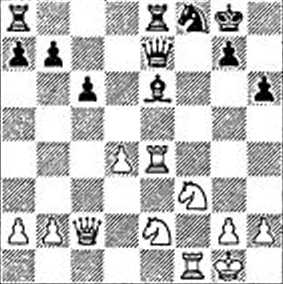
19 ... M4!
Forcing simplifications that favour Black.
20 a3
20 Фс5 Axa2.
20 ... ЙЪЗ
Better than 2O...Wc4 21 ФсЗ.
21 '^d2 ж-dS
|
22 |
2xe8 |
Exe8 |
|
23 |
QaS |
Феб |
|
24 |
ФсЗ |
'«Ъ6 |
|
25 |
2>xd5 |
cd |
|
26 |
£f3 |
£f8 |
Black wants to tie his opponent down with 27,..2c4 and 28...£lc6. However, 26...£ld8, with the same purpose, was more exact.
27 Wf2! ®g6
Intending ...Sc4 or ...£if4,
28 Qh4! £xh4
In view of the match situation, Yusupov sacrifices the exchange to force a draw. A perfectly playable alternative was 28...Ef8 29 £jf5 'Й'еб
|
or 29...ФЬ7. | ||
|
29 |
Wf7+ |
ФЬ7 |
|
30 |
Vxe8 |
Vxb2! |
|
31 |
2f2 |
®al+ |
|
32 |
2П | |
|
A natural ploy in |
such cases - | |
without changing the position you prolong the game to the adjournment, then at home you check whether there arc any winning chances.
|
33 |
an |
«al+ |
|
34 |
an |
>з2 |
|
35 |
an |
’ЩЫ+ |
|
36 |
an |
wb2 |
|
37 |
2f2 |
Vbl+ |
|
38 |
an |
<c2 |
|
39 |
Ef2 |
^cl+ |
|
40 |
an |
Wd2 |
|
41 |
Bf2 |
edl+ |
Vx-’Л
|
1 |
c4 |
£lf6 |
|
2 |
£f3 | |
|
3 |
£c3 |
Ag7 |
|
4 |
e4 |
d6 |
|
5 |
d4 |
0-0 |
|
6 |
Ae2 |
e5 |
|
7 |
d5 |
Фа 6 |
|
8 |
0-0 |
Фс5 |
|
9 |
Ski2?! |
a5 |
|
10 |
b3 |
Ah6! |
|
11 |
Wc2 |
Фе8 |
|
12 |
Axel | |
|
13 |
Wxcl |
f5 |
|
14 |
ef |
Axf5 |
|
15 |
tfe3 |
Wf6 |
|
15...b6!?. | ||
|
16 |
£k!2 |
&g7 |
|
17 |
a3? (97) | |
97 В
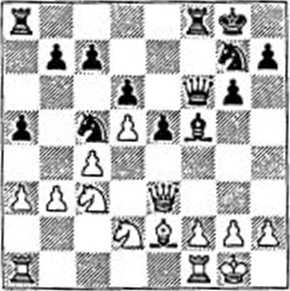
The right move is 17 f3, with roughly equal chances. Now Black gains the initiative.
17 Ac2!
18 b4
18 £b5 сб.
Mukhin-Dvoretsky
Moscow 1969 King’s Indian
|
18 ... |
ab |
|
19 ab |
2xal |
|
20 2xa1 |
£f5 |
|
21 #h3 |
21 Wf3 c4, or 21 &de4 Axe4 22 Фхе4 Wh4, is bad for White.
21 ... £d4
22 Wc3 £a6
23 £a2.
23 b5 is hardly better; the reply I had in mind was 23...£}c5 24 Afl c4 25 2a2 43f5 26 Wh3 e3 27 Sxc2 £d4 28 £dc4 &xe4 29 Qxc4 Wf4 30Ea2c2!.
23 ... e4!
24 Ecl
24 Eel Qxe2+ 25 Wxc2 Ad3, or at once 25...’Wb2.
|
24 |
£lxe2+ | |
|
25 |
Wxe2 |
Ad3 |
|
25...ВЪ2? 26&xc4. | ||
|
26 |
Wei |
Wb2 |
|
27 |
ФсЗ |
£kb4 |
|
28 |
&dxc4 |
Axc4 |
|
29 |
£j.xe4 |
£d3 |
|
30 |
Bbl |
We5!? |
I had been preparing this move, which wins a pawn. Black gains nothing from 3O...Wc2 31 Wdl Exf2 32 Qxf2 Wxf2+ 33 ФЫ We3 34 Wfl. During the game we both thought that 3O...Wd4!? was refuted by 31 We2 Wxc4 32 £g5 Wxd5 32 Wc7, but instead of 31...Wxc4?, Black can win with 31...Sf4! 32 Qg5 Exf2.
|
31 |
We2 |
£xf2 |
|
32 |
Eel |
£lxe4 |
|
33 |
Wxe4 |
Ec8! |
|
34 |
Wxe5 |
Exe5 |
|
35 |
Exe5 |
The rook ending is probably lost too.
35 ... de
36 ФГ2 Ф17
37 ФсЗ Фс7!
0-1
White resigned because after 38 c5 b6 39 Фс4 be 40 Фхс5 he will soon be in zugzwang.
|
Etruk-Dvorctsky Viljandi 1972 King’s Indian 1 c4 £f6 2 g3 g6 3 Ag2 Ag7 4 5k3 0-0 5 £f3 d6 6 d4 £k6 7 0-0 e5 8 d5 £c7 9 c4 <ki7 10 ^jcI?! f5 11 £d3 £f6 12 f4! fe 13 43xc4 £>xc4 14 Axe4 ef 14...Ah3 is weaker; after 15 Eel White intends to continue 16 fc de 17 M. 15 &xf4 Qf5 (98) | ||
|
98 W |
ill A A . 3 A A . | |
|
iai я §3 | ||
|
ЛЙ @ Й в | ||
An important position for die assessment of the variation. Black answers 16 ’tfdS with 16...’ЙТ6, followed by ...Ad7 and ...Eac8, achieving an excellent game. White should play 16 £lc6 Axe6 17 de. Then his position appears preferable, though a draw would be the most likely result.
16 g4?
A nervous move, handing the initiative to the opponent.
16 ... £d4
17 h3
17 ДсЗ <e7 IS tfd3 Sc8, with an endgame advantage to Black.
17 ... Wh4
18 #cl
Relatively best. 18 ШЗ fails to 18...Axg4! 19 hg Wxg4+ 20 ФЫ Ac 5 21 Ad2 Axf4 22 Axf4 Zxf4 23 Zxf4 Wxf4 24 ®'xd4 Zc8 25 Zcl Wh4+. On 18 Ac3. Black has 18../eg3+ 19 £g2 Zxfl+ 20 ^xfl Ac5, or even 20...Axg4.
18 ... tfxcl
19 Excl Ad7?
Irresolution! I wrongly abandon the line which I had been planning: 19...Ac5 20 £e2 £f3+ 21 Axf3 Zxf3 22 Ф£2 Zf7 (22...Zd3!?), and if 23 Ah6 Black can take the pawn on b2; otherwise ...h7-h5, opening the game for the player with the
|
bishop pair, is highly unpleasant. | ||
|
20 |
Sg2! |
Zac8 |
|
21 |
Ad2 |
Ac5 |
|
22 |
£le2 |
Qxc2 |
|
23 |
Zxe2 |
Axb2 |
|
24 |
Ebl |
Ad 4 |
|
25 |
Exb7 |
Ab6 |
25...Zxe4? 26 Zxc4 Zf2+ 27 &g3 Zxd2 28 Sxc7, and the advantage is with White.
26 £g3! Za8
26...Ac8 27 Zb8 Axg4 28 Zxc8 Axe2 29 Zc7, with equality.
27 c5! Ac8
28 cb Axb7
29 be Zac8
30 Ab4??
The decisive mistake! After 30 Aa5 White should be able to draw, even though 3O...Efc8 would still set him a few problems.
|
30 ... |
Zxc7 | |
|
31 |
Axd6 |
Zc3+ |
|
32 |
ФЬ4 |
Se8 |
|
33 |
Eb2 |
Zxc4 |
|
34 |
Zxb7 |
h6! |
|
35 |
Ab4 |
Zd3 |
|
36 |
Ac5 |
Zf4 |
|
37 |
Exa7 |
Eff3 |
|
38 |
Sa8+ |
&g7 |
|
39 |
Ea7+ |
ФГ6 |
|
40 |
Za6+ |
Фе5 |
0-1
A chessplayer who opens with 1 e4 may. if he wishes, include in his repertoire the system 1 e4 c6 2 d31? or 1 e4 c5 2 ФГЗ c6 3 d3 *?. Avoiding the French or Sicilian, White develops his pieces on the same lines as Black in the King’s Indian Defence. In so doing, he hopes to gain not only from the extra tempo that results from switching the colours, but also from the fact that Black’s ...е7-еб is not of great value here. (In the King’s Indian Defence, White very rarely plays e2-e3.)
The same type of position results from Rdti’s Opening - 1 £f3 d5 2 g3 c5 3 Д g2 Феб 4 0-0 - if Black plays ...е7-еб now or next move. (Incidentally, there are other formations for Black which also come under the heading of ’King’s Indian Attack’ provided that White develops his pieces on the King's Indian pattern.) But the present survey is based on my personal experience of this opening and takes most of its material from my own games - and I usually play 1 c4. So this move-order will receive most attention.
Some of the games given below are without theoretical significance since at least one of the players makes inferior moves in the opening.
Nevertheless, these games can still prove useful in acquainting you with the structure characteristic of this opening and the typical strategic and tactical ideas and precepts which are applied in it.
A) Black develops his bishop on e7
|
1 |
e4 |
e6 |
|
2 |
d3 |
d5 |
|
3 |
Ф<12 |
c5 |
|
4 |
Феб | |
|
5 |
g3 |
ФГ6 |
|
6 |
Ag2 |
Ac7 |
|
7 |
0-0 (99) |
99
В
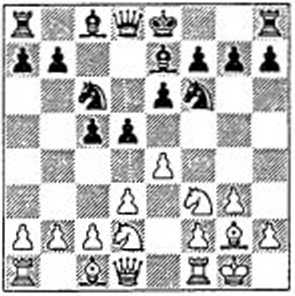
The material in this section is divided into three parts. The ’Main Line' is discussed on page 149 and •Black refrains from castling’ on page 150.
|
(1) Basic ideas for White (exam |
Black |
resigned |
in view of |
|
ples of inferior play by Black) |
22...£x(7 23 VgS g6 24 «Ъ6. | ||
|
Knight sacrifice on gS |
Knight sacrifice on d5 | ||
|
Dvoretsky-Damsky |
Dvoretsky-Yusupov | ||
|
Moscow 1969 |
Blitz game, Moscow 1987 | ||
|
7 ... 0-0 |
7 |
Vc7 | |
|
8 Eel b6?l |
8 |
Bel |
0-0 |
|
9 eS £d7 |
9 |
eS |
£d7 |
|
10 £fl Ab7 |
10 |
«’c2 |
bS |
|
11 h4 «c7? |
11 |
h4 |
aS |
|
12 Af4 bS |
12 |
£fl |
a4 |
|
Compared with the normal treat |
13 |
a3 |
b4 |
|
ment of the variation (8...b5 etc.), |
14 |
Af4 |
ba |
|
Black has lost several tempi. |
15 |
ba |
Aa6 |
|
13 fclh2 d4? |
16 |
ФеЗ | |
|
This move makes it easier for |
With the black queen on c7, the | ||
|
White to conduct the decisive at |
white knight's best route to g4 is via | ||
|
tack. |
e3, creating the strong threat of | ||
|
14 £g5! h6 |
Qxd5!. | ||
|
IS WbS! hg |
16 |
Efe8? | |
|
16 hg Efb8 |
17 |
4\xd5! |
ed |
|
After 16...Efd8 17 £g4 £f8. |
18 |
об |
’<Ус8 |
|
White has the strong move 18 Ac4, |
19 |
ef+! |
ФхГ7 |
|
with Фг2 and Ehl to follow. |
20 |
#e6+- |
$f8 |
|
17 Qg4 £f8 |
21 |
QgS |
AxgS |
|
18 Qf6+! |
22 |
Ad6+ |
Ae7 |
|
Even stronger than 18 Ae4 *^g6. |
. 23 |
AxdS |
1-0 |
|
18 ... Axf6 | |||
|
Or 18...gf 19cfe5 20 Ad5 Ad6 |
The undermining move c2-c4 | ||
|
21 'ЙЪб 22 g6 and mates. | |||
|
19 ef eS |
Dvoretsky-Gorchakov | ||
|
20 AdS! Be8 |
Moscow 1973 | ||
|
Or 20...ef 21 Be7; or 20...Ed8 21 | |||
|
<±>g2; or 2O...Vd7 21 fg £g6 22 |
7 |
0-0 | |
|
w\g6 WxdS 23 Wh6. |
8 |
Bel |
bS |
|
21 g6 £d8 |
9 |
eS |
£d7 |
|
22 gf+ 1-0 |
10 |
fS?! | |
11 cf Axf6
If ll..&xf6, then 12 Af4, attempting to seize the c5 point.
12 h4!
12 Sxc6? 43dc5.
12 - 43b6
12...h6!? 13 4k3 or 13 Qlh2.
13 3>g5! Wd6
On 13...c5, Black’s position is undermined by the powerful 14 c4!.
However after 13..,'fir'd6, it was also worth considering 14 c4!? be 15 de Axg5 (15...Фхс4 16 Фхеб!) 16 jLxg5 (or 16 hg) 16...4)xc4 17 Af4. If now 17...Sxf4 18 gf Wxf4, White has 19 Axd5!, while if 17...Wd8. then 18 eel with the threat of 19 b3.
Another good possibility is 14 ЙЪ5!? h6 15 ФеЗ (the same device as in Dvoretsky-Damsky) 15...4ie5 (if 15...£d4 or 15..JLd7, White has 16 43g4 threatening 17 4ixh6+) 16 f4! hg 17 hg g6 18 fe gh 19 cd &g7 (19...£xg5 20 £xd5!) 20 Ah3, followed by 4k3-g2-f4.
Dolmatov-Meyer
Philadelphia 1991
|
7 |
0-0 | |
|
8 |
Eel |
b5 |
|
9 |
e5 | |
|
10 |
£fl |
Г6?! |
|
11 |
ef |
Axf6 |
|
12 |
4jc3 |
Wd6 |
Dolmatov planned to answer 12...e5 with 13 c4! be 14 de c4 15 £}d2 with advantage.
13 c4! 4k7
14 4)g4 e5
|
15 |
4W6+ |
gf |
|
In the event of 15...^хГ6, White | ||
|
has the pleasant choice between 16 Jstg5 and 16 cd 4)xd5 17 4jxc5.!. | ||
|
16 |
cd |
£xd5 |
|
17 |
4M2! |
Ac6 |
|
17.J5 |
18£k4!. | |
|
18 |
Фс4 |
Wc7 |
|
19 |
£h6 |
Sfd8 |
|
20 |
Scl |
c4 |
|
21 |
•ЙЪ5 |
SacS |
|
22 |
de |
be |
|
23 |
f4! | |
|
and White has an |
undoubted ad- | |
|
vantage. | ||
An exchange of knights on d4, as a rule, is not dangerous to WQiite
Fischer-U.Geller
Netanya 1968
|
7 |
0-0 | |
|
8 |
Scl |
tfc7 |
|
8...b5. | ||
|
9 |
c5 |
£d7 |
|
10 |
Wc2 |
b5 |
|
11 |
h4 |
aS |
|
12 |
£}fl |
2x14?! |
|
13 |
4)xd4 |
cd |
|
14 |
Af4 |
Sa6!? |
|
15 |
€A2!? |
A line deserving serious attention was 15 1e'g4!? ФИ8 16 Se2, intending 4}h2-f3 with advantage to White.
On the other hand, here the standard blow 15 Axd5?l would be premature, in view of the counter-blow 15...ДЬ4!. The following variations are possible:
|
(a) 16&d2?!cd 17сбШГ4!? 18 |
27 ExeS Wd7 |
|
gfSxc6 19>dl3g6+and 20...ФГ6, when Black has a strong attack.
Vxdl+!.
|
28 h5! fg 29 hg! gf+ On 29...Sxf3, White has 30 Sc8+! #xc8 31 «xh7+ ФС8 32 g7+. 30 ФхГ2 hg 31 «xg6+ ФЬ8 31...^7 32 Sg51. 32 Sh5+ 1-0 (2) The Main Line |
|
work: 18 Wxc6 Wxf4 19 Wxd7 ЙТЗ 20Qh2!. 15 ... Sc6 16 Sacl Даб? But now White's thematic strike against d5 secures him the advantage. Black should have chosen between 1б...’ЙЪб and 1б...ДЬ4. 17 Axd5! ed 18 c6 Wd8 19 cd £сб 20 ^g4! f5 If 2O...'firxd7, then 21 Де5 is decisive. 21 ЙЪ5 #xd7 22 £f3 g6 23 «Ъб ДГ6 24 Sxe6 вхеб At this point the obvious-looking 25 Sei? would unexpectedly lead to a draw after 25...’Й’хе1+!! 26 Фхе1 Ag7 27 »g5 Af6. 25 Де5!’ An elegant coup, after which While's positional plus becomes decisive. 25 ... Дхе5 26 Sei f4l? |
Fischer-Miagmasurcn Sousse IZ1967
White should notallow I3...a3 14 b3 £la7, when the knight comes round to c3.
Now Black constantly has to reckon with the central thrust c2-c4. 14 £a5?’ 14...5M4!?.
Clearly Fischer is preparing ^g5. Another stock plan is 16 h5, intending 17 h6 g6 18 £g4 followed by play on the weakened dark squares on the kingside f«i'd2, &g5 etc.). 16 ... d4 17 £>fl &b6 |
|
18 |
&g$ |
£>d5 |
|
19 |
ld2 |
£xg5 |
|
20 |
^xg5 |
Wd7 |
|
21 |
Wh5 |
Sfc8 |
|
22 |
<53d2 |
ФсЗ |
|
23 |
ДГ6! |
^e8 |
23...gf 24 ef £h8 25 4ИЗ Zg8 26 Фс5, and White wins.
|
24 |
Фе4 |
g6 |
|
25 |
<g5! |
<Sxe4 |
|
26 |
Sxc4 |
c4 |
|
27 |
h5! |
cd |
|
28 |
Zh4 |
3a7 |
28...dc 29 hg fg 30 Sxh7 is also bad for Black.
|
29 |
£g2!! |
de? |
|
29...Ш. 30 'ЙЪб | ||
|
31 |
Wxh7+! |
1-0 |
Dvorctsky-Tseshkovsky USSR Ch (First League). Odessa 1974
|
7 |
0-0 | |
|
8 |
aC1 |
bS |
|
9 |
c5 |
£d7 |
|
10 |
£fl |
b4 |
|
11 |
h4 |
aS |
|
12 |
ДГ4 |
Se81? |
|
An |
interesting |
prophylactic |
|
move. | ||
|
13 |
^.c3 |
£a6 |
|
14 |
a4?! |
The start of an unsuccessful plan. 14 h5, aiming for 3)g4 and h6, was stronger.
14 ... ba
15 ba
White is playing for c2-c4.
15 ... 2c8
16 Za2?!
In reply to the immediate 16 c4,1 didn't like 16...de 17dc£lb6 18 £d2 'йс4. The move played is an attempt to strengthen this plan - for example. 16...34?! 17 c4 ФЬ6 18 Sd2l. On the other hand after 16...ФЬ6, I imagined that the attack with 17 £}g5 would gain in strength.
However, White's idea is incorrect. Preferable moves were 16 ФЬ2 and 16 Ah3.
16 ... £b6
17 Qg5?
Played without due consideration. But then. Black was already threatening 17...d4.
17 ... h6
Only now did I discover that all White’s combinative tries arc easily refuted: 18 ЙЪ5 (18 £xf7 ФхГ7 19 ЙЪ5+ g6!) 18...hg 19 hg g6 20 «Ъ4 (20 «ЪЗ £xg5) 20...<£d4 21 £h2 €>f5 22 £xf5 ef 23 3h 1 Д f8 24 £g1 Д g7. or 21 £g4 2)f5 22 Wh3 Д xg5.
18 £h3 ДГ8
White’s play has come to a dead end. With possibilities of ...d5-d4 or ...^d4 at his disposal. Biack is clearly better.
(3) Black refrains from castling
Dvoretsky-Cook St John 1988
7 ... b6
8 Sei ДЬ7
9 c3 &c7
9...0-0.
10 #e2
The Encyclopaedia of Chess Openings recommends 10 e5 £d7 11 d4 and 12 Qfl.
|
10 ... 11 a3 |
0-0-0 Даб |
|
It was worth |
considering |
|
U...h6!?, and if |
12 b4, then |
|
I2...£e5. | |
|
12 e5 |
£d7 |
|
13 h4 |
h6 |
|
14 h5 |
£f8 |
|
On 14...g5, White |
was intending |
|
15 hg fg 16 ДЬЗ £f8 17 £f 1 or 17 | |
|
b4’?. | |
|
15 b4 | |
|
15...Г6 1беГДхГ6 |
17 Sbl. |
|
16 Sbl |
ДЬ7 |
|
17 be |
be |
|
18 £b3!? |
Даб? |
Better is 18...gh 19 ДеЗ £d7 20 c4d4 21 ДГ4 Sdg8.
19 ДеЗ! £xe5
19...C4 20 £c5 Дхс5 21 Дхс5
|
with an attack. | ||
|
20 |
£xeS |
WxeS |
|
21 |
Wc2 |
o’c7 |
|
22 |
c4 |
d4?! |
|
23 |
Ad2 | |
White has a decisive advantage.
|
23 ... |
£d7 | |
|
24 |
hg |
e5 |
|
25 |
£a5 |
£b6 |
|
26 |
£c6 |
fg |
|
27 |
SxeS |
даб |
|
28 |
Зеб |
3d7 |
|
29 |
Да5 |
ФЬ7 |
|
30 |
£xa7+ |
Фха7 |
|
31 |
ДхЬб+ |
Wxb6 |
|
32 |
ЗхЬб |
ФхЬб |
|
33 |
«а4 |
3hd8 |
|
34 |
«сб+ |
Фа7 |
|
35 |
Sxd6 |
1-0 |
When the black king stays in the centre, the plan of exchanging on d5 is also feasible.
Dvoretsky-Bogomolov Moscow 1967
1 ... b5
8 Eel
The immediate 8 ed! cd 9 c4! is also good.
‘ 8 ~ ДЬ7
The typical thrust in the centre.
10 ...
13 £c4
White’s position is somewhat preferable. He subsequently succeeds in outplaying his opponent: 13...ДГ6 14 Ag5!? Дх85 15 £xg5 £d4 16 Wd2 h6 17 £e4 £b4 18 Sadi £bc2 19 Sfl f5 20 £f6+ Bxf6 21 ДхЬ7 Sad8 22 ФЫ «Т7 23 £a5 3b8 24 Д82 Exb2 25 «сЗ 3b5 26 a4 Sbb8 27 Wxc5 Ebc8 28 £c6 Exc6 29 Дхсб Sc8 30 «’xc2! Sxc6 31 «d3 3d6 32 f3 «d5 33 Scl ФЬ7 34 g4 «П 35 Bc4 1-0 (Black lost on time)
If White plays e4-c5, Black should try to get in -g7-g5; the
verdict on the position depends on this thrust
Chckhov-A.Ivanov
Sochi 1975
Clearly 7...£f6 is weaker in view of 8 ed £xd5 (8...cd 9 Sel+) 9 £b3 Ьб 10 c4 £c7 11 d4.
8 Eel (100)
|
1 |
g3 |
£f6 |
|
2 |
4g2 |
dS |
|
3 |
£13 |
c6 |
|
4 |
0-0 |
Де7 |
|
5 |
d3 |
Ьб |
|
6 |
£bd2 |
ДЬ7 |
|
7 |
e4 |
c5 |
|
8 |
eS |
£fd7 |
|
9 |
Bel |
£<6 |
|
10 |
£fl |
Wc7 |
too в

Й ш %
Already 10...g5!? was worth considering.
11 Af4 h6
12 h4 d4?
Better is 12...0-0-0 13 ФеЗ £13.
After the text White won the game as follows: 13 c3! de 14 be 0-0-0 15 d4 £13 16 £ld2 £g617Ae3cd 18 cd Ab4 19 Wa4 £gc7 20 a3 Axd2 21 £xd2 ФЬ8 22 Eacl £d5 23 £c4 Bd7 24 Ec2 Ec8 25 Eccl Sdd8 26 Afl >c7 27 Ad2 #f3 28 Ехсб Ехсб 29 Ехсб #e8 30 £b5 аб 31 Ec8+ 1-0.
В) Black develops his bishop on g7
|
1 |
e4 |
e6 |
|
2 |
d3 |
d5 |
|
3 |
£d2 |
cS |
|
4 |
£g!3 |
£c6 |
|
5 |
g3 |
g6 |
|
6 |
4g2 |
Ag7 |
|
7 |
0-0 |
£ge7 |
(1) Castling is bad for Black -White’s attack is very dangerous
Dvorctsky-Ubilava
Tbilisi 1979
8 ... 0-0
Belter is 8...b6.
9 e5!
White proceeds with a standard plan of attack: £f 1, h4. £.f4, £h2-g4 etc. Black’s defence is more difficult here than in the system with the
bishop on c7, since his kingsidc dark
|
squares |
have been |
weakened by |
|
...g7-g6. | ||
|
9 |
Wc7 | |
|
10 |
■#e2 |
a5 |
|
11 |
h4 |
h6 |
|
12 |
£fl |
White could try 12 a4!?, with c2-c3 and £f 1 to follow.
12 - a4
13 аЗ b5
13...£d4!?.
14 &lh2
15 ДГ4
16 £)g4
b4
Ф117
£g8 (101)
25 Sd6! ДЬ7
26 Sxe6 .. '. i
26...ФГ5 27 £d5 Wf7 28 Sxc6 Дхсб 29 сб and wins.
101 w
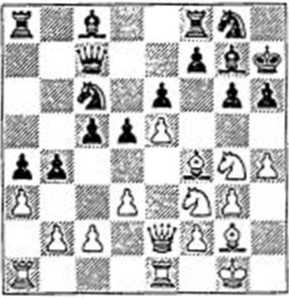
|
27 |
<2ixd4 |
cd |
|
28 |
Wd3 |
Дх82 |
|
29 |
*±’xg2 |
an |
|
30 |
Shi! |
CT5 |
|
31 |
g4 |
«Ъ7+ |
|
32 |
*gl |
£c3 |
|
33 |
ДхеЗ |
«ТЗ |
|
34 |
*Xg6 |
ДхГб |
|
35 |
Sxh6+ |
1-0 |
Dvoretsky-Khalifman
Sverdlovsk 1987
17 c4!
After 17 h5 g5. the sacrifice on g5 does not work. To obtain an improved version, White wishes to conquer the e4 square by attacking the black d-pawn with his own c-pawn.
17 be
18 be Даб
19 c4! de
20 de
Now 21 h5 (intending to meet 21...g5 with 22 jLxg5) cannot be parried.
20 ... SabS
21 h5!
Not21fcf6+?$h8 22 h5 g5.
21 ... ФИ8
21...g5 is met by 22 Axg5!.
22 hg fg
23 &f6! £gc7
23...^d4!?,
24 Sadi
24 £h4!?.
24 ... Sbd8
|
8 ... |
0-0?! |
|
9 e5! |
®'c7 |
|
10 tfe2 |
b6 |
|
11 h4 |
Даб |
|
12 £fl |
Another quite good line seems to be 12 c3!?, but then White has to reckon with 12...f6 13 of Exf6 14 £fl e5.
12 ... £d4
13 £ixd4 cd
14 ДГ4 €кб?!
A better idea was 14...Sac8 15 Sacl '«r'c5, aiming to attack the quccnside pawns with his queen. All the same, 16 <\h2 followed by <Sg4 or h4-h5 would give White a dangerous attack.
15 a3 tfd7
I would have met 15...3ac8!? by the simple 16 Sacl!, since 16£h2?! allows Black to confuse the issue with 16...Дхе5! 17 Дхс5 Qxc5 18
>xe5 Wxe5 19 Sxc5 Sxc2.
16 £h2 Zae8
17 £g4 f6
After 17...h5 I8£f6+£xf619ef (threatening 20 Ah6) 19...ФИ7 20 Де5 and 21 f4, White would obtain an overwhelming advantage.
18 ef Axf6
19 Qxf6+ Zxf6
20 ДЬЗ Zxf4
2О...Дс8 21 Де5 is also hopeless.
|
21 |
gf |
Дс8 |
|
22 Wf3 22 f5 e5. 22 ... |
af7 | |
|
23 |
«^3 |
ФЬ8 |
23...3Г8 24 f5.
|
24 |
2e2 |
Zf8 |
|
25 |
3ael |
£d8 |
|
26 |
f5! | |
|
27 |
<e5+ | |
|
28 |
*xg7+ |
&xg7 |
|
29 |
f4 |
and White won the ending.
(2) White should not push his pawn to e5 before Black has castled short, becaus^of counterplay with ...h7-h6 and ...g6-g5
Dvoretsky-Anikaev USSR Ch >Af Odessa 1972
|
8 |
••• |
b6 |
|
9 |
e5?! |
Wc7 |
|
10 |
We2 |
h6! |
|
11 |
h4 |
85! |
|
12 |
hg |
hg |
|
13 |
&xg5 |
WxeS! |
|
14 |
VxeS |
Фхе5?! |
After 14...Axc5! Black would have the better game.
15 Qc4!? (102)
102 в
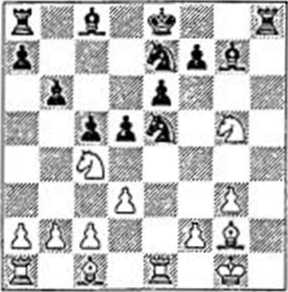
15 ... £хс4?!
He should have decided on a positional exchange sacrifice: 15...dc’ 16 Дха8 cd.
16 de ДЬ7
17 c3
17 a4!?.
17 ... 0-0
18 cd?!
A stronger move was 18 a4!, with somewhat the better chances for White. The reply 18...Дсб? fails to 19 £xe6! fe 20 Zxe6.
|
18 |
Axd5 | |
|
19 |
£xd5 |
£xd5 |
|
20 |
£e4 |
Sfd8 |
|
21 |
£g5 |
f6 |
|
22 |
jLdl |
Zd7 |
|
23 |
Se2 |
¥i.«A |
(3) Maintaining the central tension
Dvoretsky-Averkin USSR Ch (First League), Odessa 1974
9 c3
On 9...Даб?! White has 10 ed £xd5 ll’w'a4.
The ending after 11...de 12 de ’er'xdl 13 Sxdl is clearly more pleasant for White.
12 c4 c5
13 h5
13 £}3h21? followed by f2-f4.
13 Дс8
13...<d7!?.
14 £h4
14 &3h2.
14 ... ДГ6
15 hg fg
16 Г4 h5!
Not 16...ef? because of 17 £lxg6! 5ixg6 18 e5.
17 f5?!
17 £h2.
17 ... gS
Black now has the better position, since White has no active possibilities.
DoImatov-A.SokoIov Manila IZ1990
8 ... b6
9 c3
In Dolmatov’s view, 9 Qfl is more accurate; White intends to play 10 c5, for example in answer to 9...d4. On the other hand, 9...de 10 de 'S'xdl 11 Sxdl gives White a favourable ending similar to that which arose in the game.
9 ... a5!?
10 an
White is aiming for e4-e5. In Ljubojcvic-Kasparov, NikSid 1983, where the moves 9 h4 h6 had been inserted, Wnitc played instead 11 a4, to which Kasparov replied 1 l...Ba7!?. Dolmatov refrained from 10 a4 because he was worried about 10...d4.
10 ... de
It was worth considering 10...d4 or 10...a4.
|
11 |
de |
i»xdl |
|
12 |
Sxdl |
a4 |
|
13 |
Bbl! |
0-0 |
If I3...a3, then 14 ba, attacking the pawn on b6.
14 ДГ4 eS
After 14...a3 15 Sdcl! ab 16 Sxb2, the pawn on b6 is vulnerable. 1б..лйЬ4? fails against 17 Hd2! Фха2 18 Bal.
15 ДеЗ Деб
16 ЬЗ ab
17 ab
White’s position is clearly preferable.
18...Bd3 19Bdcl and20Afl.
19 ДП
20 Дс4 is premature in view of 20...ФП.
20 ... Ba3?
It was essential to exchange on b4, so as to open the diagonal for his dark-squared bishop and utilise the d4 point when appropriate.
21 be be
22 Edel £c8
23 Ac4 Axc4
At this point 23...ФГ7? fails to 24 Eb7+.
|
24 |
£)xc4 |
Ea4 |
|
25 |
&fd2 |
£d6?! |
|
26 |
Qb6 |
Ea2 |
|
27 |
Bal |
Exal |
|
28 |
Exal |
f5 |
|
29 |
2>d5 |
fc? |
|
29...ФП. | ||
|
30 |
£f6+ |
ФГ7 |
|
31 |
ЗДхс4 | |
White now has a decisive positional advantage, which Dolmatov accurately conducts to victory: 3l...£f5 32 Баб ФхеЗ 33 fe £b8 34 Ef6+ Фе7 35 Eb6 £d7 36 Sc6 Ea8 37 ФГ2 Ea2 38 Фе2 Фd8 39 ФёЗ Ae7 40 h4 £b8 41 Ec6 £>d7 (41...*d7 42 Exc5 £c6 43 2>xc5+) 42 £c4 Eg2 43 £a5 Af8 44 Qc6+ Фс7 45 Qxc5 Фхс5+ 46 Exc5 Фd8 47 h5 Ac7 48 hg hg 49 Ec6 g5 50 Ec5 Ф67 51 Фс4 Egl 52 Qxg5 Sxg3 53 £tc4 Eh3 54 Фхс5+ Фd8 55 £k:6+ Фд7 56 &14 Af6 57 Zf5 Фс7 58 ФdЗ Eh 1 59 c4 Bal 60 Eb5 Ea3+ 61 Фе4 Ф67 62 Eb7+ Фс8 63 Eb3 Sal 64 Фё5 Edl 65 c5 1-0 (4) Exchange of pawns on d5
Yurtaev-Dvoretsky
Frunze 1983
9...Ab7.
Two strong replies to 10...£jxd5 arc 11 •Ek4 and 11 d4 cd 12 $3xd4 £)xd4 13 Axd5.
13 d4
White could try 13 h4!?.